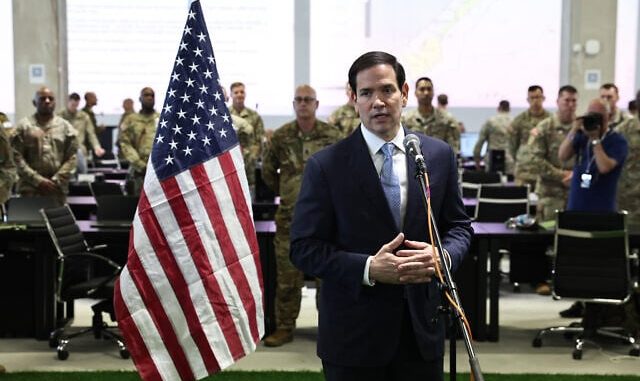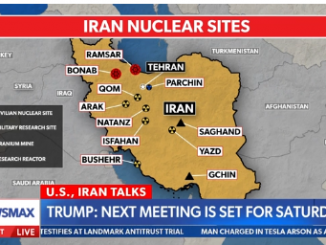
US Secretary of State Marco Rubio speaks to the media at the Civil-Military Coordination Center in Israel, October 24, 2025. (Fadel Senna/Pool Photo via AP)
Published October 26, 2025
U.S. Secretary of State Marco Rubio confirmed that Washington is drafting the outline of a United Nations–backed resolution that would authorize a multinational peacekeeping or stabilization force in the Gaza Strip. Speaking ahead of a scheduled visit to Doha, Qatar, Rubio said the U.S. has been consulting with multiple governments to design a framework that could secure broad international legitimacy and participation.
Building a Legal Foundation
Rubio explained that the United States is “getting input from various partners” on how to structure the mission, noting that many potential contributors require a UN mandate before deploying troops or funding operations. “Several of the countries we’ve spoken to are going to need that resolution, or something comparable, because their domestic laws demand it,” he said.
According to Rubio, the plan under discussion envisions a limited international force operating in Gaza to maintain stability after the cessation of hostilities, oversee the transition to local governance, and prevent the resurgence of militant activity. The proposal is part of a broader U.S. effort to guide Gaza toward post-conflict reconstruction while ensuring Israel’s security concerns are addressed.
Israel’s Security and Hamas Exclusion
Rubio emphasized that any post-war governance structure “cannot include Hamas,” calling it a prerequisite for peace and stability. He also stated that the composition of the multinational force must consist of countries Israel is comfortable working with. “Israel’s security is non-negotiable,” he said, adding that no country viewed as hostile to Israel will take part in the mission.
Israeli officials have reportedly signaled conditional openness to such a plan, provided the force’s rules of engagement and national composition align with Israel’s red lines. The arrangement could pave the way for an international administration to temporarily oversee Gaza until local institutions are rebuilt.
Role of Qatar and Regional Actors
Rubio’s trip to Qatar underscores the Gulf state’s role as a diplomatic intermediary. Qatar has maintained communication channels with both Israel and Hamas, making it a potential venue for coordinating humanitarian access and discussions over reconstruction. Rubio is expected to meet Qatari officials to discuss the scope of their involvement and to seek financial or logistical support for the multinational mission.
The Times of Israel reported that the U.S. is preparing a draft UN Security Council resolution, which would serve as the legal basis for deploying a peacekeeping force. The resolution would outline responsibilities, duration, and coordination mechanisms with Israel and regional partners.
The Broader Context
The initiative comes amid growing international pressure for a sustainable framework to govern Gaza after months of intense conflict. While Washington has consistently backed Israel’s right to self-defense, Rubio’s statements suggest a shift toward securing multilateral consensus on Gaza’s future. The U.S. goal, according to officials cited by Newsmax, is to prevent a governance vacuum and ensure that humanitarian relief and rebuilding efforts are properly coordinated.
Rubio framed the effort as part of a “rules-based international approach” to restoring order while avoiding permanent U.S. military presence. A small number of American personnel may participate in logistical or advisory capacities, but there are no plans for U.S. combat troops in Gaza.
Challenges and Questions Ahead
Several hurdles remain before the plan can take shape:
-
UN Authorization: The Security Council’s approval could face political obstacles, especially if Russia or China raise objections.
-
Force Composition: Countries from Europe, Asia, or the Arab world might be asked to contribute, but each has its own legal and political constraints.
-
Mandate Clarity: Whether the force will engage in peacekeeping, stabilization, or limited enforcement will determine its scale and risk level.
-
Transition Governance: With Hamas excluded, who will administer Gaza? Proposals range from an interim Arab-led authority to a UN-managed transition body.
-
Coordination with Israel: The success of any mission hinges on close coordination with Israeli defense and security agencies.
 Implications of Rubio’s UN-Backed Gaza Force Proposal:
Implications of Rubio’s UN-Backed Gaza Force Proposal:
1. U.S. Foreign Policy Shift
Rubio’s push for a UN-sanctioned multinational force signals a departure from the U.S.’s traditional approach of supporting Israel primarily through bilateral security cooperation. This new framework emphasizes multilateral legitimacy—a move designed to share responsibility, reduce anti-U.S. sentiment, and reassert Washington’s leadership within international institutions. It also reflects an attempt to rebuild confidence among European and Arab partners after years of fractured Middle East policy.
2. Israel’s Strategic Position
For Israel, the plan offers both opportunities and risks. On one hand, it could relieve the Israel Defense Forces (IDF) from the burden of long-term occupation or security administration in Gaza. On the other, allowing an international force introduces new variables—foreign command structures, limited operational control, and potential diplomatic pressure. Israel’s insistence that only “friendly” nations participate underscores its determination to prevent the force from being used as leverage against it in future conflicts.
3. Arab World Diplomacy
The initiative could reshape Arab diplomatic alignment. States like Egypt, Qatar, the UAE, and Jordan may gain influence through participation, while Iran and its proxies would likely view the force as a challenge to their regional reach. For Qatar in particular, acting as host and mediator enhances its reputation as a power broker, balancing relations with both Washington and Hamas. The outcome could either foster cooperation among Sunni-led governments or deepen rivalries depending on how the force is composed.
4. UN Credibility and Global Governance
A successful UN-backed mission in Gaza could revitalize confidence in multilateral conflict-resolution mechanisms—something the UN has struggled with since Syria’s civil war. Conversely, if the plan stalls or becomes politically gridlocked, it will highlight the UN’s limitations in managing 21st-century asymmetric conflicts. The U.S. therefore risks reputational damage if the proposal falters after major diplomatic buildup.
5. Palestinian Governance and Reconstruction
The exclusion of Hamas from Gaza’s future governance sets the stage for a new political entity—possibly an Arab-led transitional authority or a UN-managed administration. If executed effectively, this could open channels for billions in reconstruction funding and humanitarian aid. However, without local legitimacy or Palestinian buy-in, the force could be viewed as an occupying power, undermining its stabilizing intent and igniting new unrest.
6. Economic and Trade Dimensions
Beyond security, Gaza’s stabilization has potential economic consequences. A functioning governance structure could reopen trade routes, allow international contractors to participate in rebuilding efforts, and create new markets for construction materials, fuel, and technology. For regional economies—including Egypt, Jordan, and the Gulf states—reconstruction could mean fresh revenue streams and job creation. Yet, without transparent oversight, reconstruction funds risk being misused or politicized, repeating the failures seen in Iraq and Afghanistan.
7. Regional Power Balance
Should the plan succeed, it would mark the first major multinational Arab–Western cooperation since the anti-ISIS coalition—redefining the Middle East’s postwar order. A failure, however, could embolden Iran, Hamas remnants, and militant networks that thrive in power vacuums. The stakes, therefore, extend beyond Gaza, touching Lebanon, the Red Sea corridor, and even U.S. credibility in Asia and Europe.
8. Long-Term Outlook
Ultimately, Rubio’s initiative represents both an opportunity and a gamble. If the force can secure peace and rebuild governance without inflaming regional rivalries, it could serve as a template for future crisis management. If not, Gaza may once again become a symbol of international paralysis—where global powers talk of stability but deliver only temporary calm.
 Overall Takeaway:
Overall Takeaway:
Rubio’s initiative highlights both promise and peril. It reaffirms America’s moral commitment to protect its allies and confront terrorism, yet it also reminds policymakers that sovereignty and strength—not bureaucracy—are the real foundations of peace. The UN may offer structure, but history shows that lasting security often depends on decisive national leadership, not endless debate in international forums.
If the U.S. can build a coalition that defends Israel, deters Iran, and rebuilds Gaza without surrendering control to global institutions, it will prove that principled power still matters in a world that too often mistakes compromise for peace.
SOURCES:
NEWSMAX – Rubio to Discuss Multinational Gaza Force During Qatar Visit
REUTERS – Rubio says US is getting input on Gaza international force, will discuss in Qatar
THE TIMES OF ISRAEL – Rubio says US ‘working on outline’ of UN resolution authorizing Gaza peacekeeping force
THE DAILY TIMES – Secretary Rubio: UN-backed multinational force for Gaza





Be the first to comment